
Welcome to our bi-weekly Club of Amsterdam Journal. Found today searching Google News: Google finds 46% profit rise as it cuts into rivals and lowers costs “We’ve had numerous reports that Google.cn and other search engines have been blocked in China and traffic redirected to other sites,” said a Google spokesperson in an e-mail. “While this is clearly unfortunate, we’ve seen this happen before and are confident that service will be restored to our users in the very near future.” Google Video Ads Showing Faster Growth Than Expected Ballmer: Microsoft will dunk on Google…eventually Should The Government, Google, Or Another Company Manage Medical Records? Viacom expressed reservations today at the Web 2.0 Summit about Google’s plan to enter YouTube content into a database and give owners the chance to remove it. Take a look at our next Season Event the future of Google – October 25, 18:30-21:15 NEW LOCATION: De Industrieele Groote Club, Dam 27, Amsterdam |
Felix Bopp, editor-in-chief
Alexandria burned – securing knowledge access in the age of Google
| Abstract This article expands upon my previous VINE article entitled ‘Legal Issues facing the Knowledge Economy in the 21st Century’ by concentrating on one main topic, that of knowledge access specifically to works available currently in analog form. Most libraries face the daunting task of preserving their hard copy collections in a way not contemplated by Johan Gutenberg. How to preserve library collections in a manner permitted under copyright law is the primary legal issue, but the legal analysis does not end there. Contract, licensing, and vendor-driven solutions may leave the ultimate user without access to vital resources heretofore only available within the physical library environment. I will address not only copyright issues and related fair use and first sale doctrines, but antitrust issues, and the relationship between fair use and the 5th amendment. The recently initiated Google Library Project offers a useful test scenario as the debate continues between traditional hardcopy volumes and their digital counterparts. By way of analogy, I will compare the ancient Alexandrian libraries with that proposed by Google. ****Perhaps by the time you read this article the dilemma presented here will be resolved. Such is the nature of the Internet. In the event that the dilemma is not resolved, this article will expand upon some ideas discussed in my last article on legal issues in the knowledge-based economy for the 21st century. My focus will be almost entirely on knowledge access. Specifically, I will review the legal issues facing an entity that is attempting to create a library containing the world’s books and making that library available for search purposes online.Initially, I will show that the issues being faced by the above-identified communities are not unique to this century, or even the past thousand years. I have chosen as an analogy the lost libraries of ancient Alexandria in Egypt as the starting point. Next, I will outline contemporary legal issues that face an organization attempting to emulate the intent of the Ptolemies, most of which were not considered by the founders of the original “world library”. I will compare the methods used by the knowledge acquirers in the time of the pharaohs with those used by mere mortals. Finally, I will identify the legal hurdles facing a commercial online digital library which will be laws relating to copyright, private property, and antitrust. […] Google has an opportunity, although not a duty, to set precedents for the future digital archives of not only an American cultural heritage, but one for the expanse of human history. A good faith effort to cooperate with the authors and publishers whose works populate their digital space by following the laws already forged by public debate should not be ignored in favor of technological expediency and perhaps ephemeral and temporary gain. What is at stake here is not just providing an Internet search service that also happens to link search results with commercial advertisements, but a tool assisting with knowledge accumulation and access for generations.” You can download the full article as a pdf file incl. resources and credentials click here |
Next Event
the future of Google
and its impact on Media and Entertainment
Thursday, October 25, 2007
Registration: 18:30-19:00, Conference: 19:00-21:15
NEW LOCATION: De Industrieele Groote Club, Dam 27, AmsterdamThe conference language is English.
The speakers are
Nils Rooijmans, Head of Search and R&D, ilse media
Search Culture
Mario de Vries, Business Consultant, Triple P
“Any resemblance with real life is purely coincidal”
Rocco van den Berg, Head of Business Development & Licensing, Endemol The Netherlands
The increase of serious video channels
Arjen Kamphuis, Futurist, Owner, KMPHS
Futureshock – Dealing with rapid and fundamental change
Moderated by Simon Jones, University of Amsterdam
Supporter: Info.nl
Club of Amsterdam blog
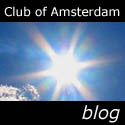 | Club of Amsterdam blog http://clubofamsterdam.blogspot.com November 8: Sexuality in the 21st Century? September 6: Are chimeras part of our future? September 1: Importance of Multiculturalism Expertise, and a Program to Acquire It September 1: Four Planets |
News about the Future

World Investment Report 2007
The Report analyses the latest trends in foreign direct investment (FDI) and puts a special focus in 2007 on the role of transnational corporations (TNCs) in the extraction of oil, gas, and metal minerals.
As in previous years, World Investment Report 2007 (WIR07) presents the latest data on FDI and traces global and regional trends in FDI and in international production by TNCs. Global FDI inflows rose in 2006 for the third consecutive year. This growth was shared by all major country groups: developed countries, developing countries and the transition-economies of South-East Europe and the Commonwealth of Independent States . Rising demand for commodities was reflected in a steep increase in natural resource-related FDI, although the services sector continued to be the dominant recipient of FDI. Among the developing regions, FDI inflows to subregions such as North Africa, sub-Saharan Africa, West Asia, South Asia, East Asia, and South-East Asia were at record levels, as were foreign investment flows to transition economies.

International Data Protection and Privacy Commissioner’s conference
Remarks from the conference: “The very nature of international travel warrants an international approach to establishing standards that safeguard passenger data,” says Jennifer Stoddart, Canada’s Privacy Commissioner. “The transfer of personal information among travel agents, carriers and any number of domestic and foreign governments poses an ongoing threat to the personal privacy of passengers.”
Michael Geist commenting Michael Chertoff, Secretary of the U.S. Department of Homeland Security: “Chertoff seemed to say there is a known reality about our future course and there is little that the privacy community can do about it.”
N.I. Vavilov Institute of Plant Industry
The N.I. Vavilov Institute of Plant Industry is the only research institution in Russia whose activities include plant genetics resources (PGR) collection, conservation and study. This Institute, its accomplishments, and role in maintaining the global ex situ collection are well known world-wide. Its global PGR collection represents plant diversity encompassing 320,000 accessions of 155 botanical families, 2,532 species of 425 genera. For instance, the collection harbours 95,000 accessions of grain crops, over 43,000 of legumes, 52,000 of groat crops, 26,000 of industrial crops, 28,000 of fodder crops, about 10,000 of potato, and 50,000 of vegetables. VIR also maintains a herbarium of 260,000 specimens.
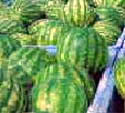 | Astrakhan experiment station The Station was opened in 1966 and is situated 14 km from Astrakhan. At this station the collections of rice, watermelon, melon, pumpkin, tomato, alfalfa, forage grasses and ornamental plants are studied. In particular, the station performs biochemical assessment of accessions and analyses of tomato physiology under saline soil conditions. | |
 | Daghestan experiment station The Station was organised in 1969 on the Caspian Sea shore, 10 km from Derbent, and has been studying the collections of wheat and its wild relatives, barley, oat, vegetables, fruit plants and valuable local forms of grapevine. The climate provides a natural background infested by virulent races of brown, stem and yellow rust, which helps to make precise evaluation of accessions by their rust resistance. This station performs genetic analysis of wheat accessions in order to identify donors of male sterility and fertility restoring lines. | |
 | Far East experiment station The Station (20 km from Vladivostok) has existed since 1929 and studies field crops, vegetables, fruits and berries, grapes, actinidia, aboriginal forms of plum, apricot, magnolia vine, honeysuckle and Amur grape. More attention is allocated to soybean, genetics proper of this crop and its resistance to fungi. The station breeds potato cultivars and introduces wild forage grasses into cultivation. | |
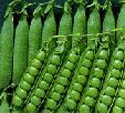 | Yekaterinino experiment station The Station was organised in Tambov Province (25 km from Michurinsk). It identifies sources of resistance to fungous diseases in leguminous crops, initial materials for breeding of nematode resistant potato with high content of starch. The station maintains duplicate collections of pea, lentil, vetch, small grains and perennial grasses. | |
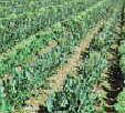 | Krymsk experiment breeding station The Station was included in the Institute’s network in 1935. It is situated in the town of Krymsk, Krasnodar Region, and studies the collections of green pea, sugar maize, tomato, pepper, eggplant, cucumber, apple, plum, peach, pear, apricot, strawberry and some other crops. It is involved in vegetable and sugar maize breeding programmes. | |
 | Kuban experiment station The Station was established in 1924 in the steppe zone of Krasnodar Region. It performs studies of maize, sorghum, sunflower and castor oil plant, immunological research on wheat, barley, chickpea and sunflower, and on flax resistance to Fusarium wilt. The National Seed Store is situated on the territory of this station. It houses the base collection of the Institute within a temperature range from +4°C to -18°C. | |
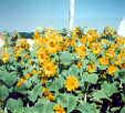 | Maikop experiment station The Station was established in 1930. It has been studying the collections of cultivated and wild grasses, maize, Jerusalem artichoke, potato, winter rapeseed, and southern varieties of apple, pear, plum, sweet cherry and filbert. There is a quarantine nursery at this station. The station specializes in research on onion, pepper, eggplant, cucumber, cabbage, garlic, carrot and red beet. Heterosis hybrids of cucumber and tomato are bred at the station. | |
 | Moscow division The Station was opened in 1957 in the town of Mikhnevo near Moscow. It has been working with cereals, legumes, forages, vegetables, potato and hop. The research on the effect of ionizing radiation and chemical supermutagens on the heredity of agricultural and horticultural crops is concentrated here. It also studies mutants and the prospects of their utilization in plant breeding, resistance of plants to diseases and pests, and physiology of environmental stress resistance. | |
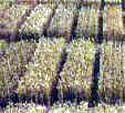 | Pavlovsk experiment station The Station was organised in 1926 near St. Petersburg. Being one of the major stations of VIR, it studies perennial grasses and cruciferous tubers cultivated in the Non-Black-Soil area. There are over 3000 accessions of fruit and berry plants maintained in vivo in its gardens. More than 40 of these fruit samples have been commercialized. This station operates an experiment farm, a quarantine nursery and greenhouses. | |
 | Polar experiment station The Station was opened in 1923 near the town of Kirovsk beyond the Polar Circle. It is a kind of natural laboratory for studying crop variability and their physiological characters under the growing conditions of the Far North. Cereals, vegetables, forage crops, berries and potato are studied here. The station is involved in biochemical, physiological, immunological and chemical weed control research. | |
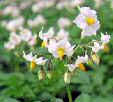 | Volgograd experiment station The Station, established in 1932, is located in flood lands of Volga. It is comprised of the departments of vegetables, fruit plants, vegetable and potato seed production, and laboratories of biochemistry and technology, physiology and immunology. Plant genetic resources collections are studied under intensive irrigation conditions. This station possesses a big experimental farm and supplies scientific institutions with breeding materials. | |
 | Zeya experiment station The Station was established in 1985. This station collects old landrasces and forms of cultivated plants and their wild relatives in the Far East and Eastern Siberia. It provides complex study of the collected samples and those from the Institute’s collection in order to identify the most promising accessions of cereals, vegetables, industrial crops, small fruit plants and potato. Also, it renders scientific assistance to local farms. | |
Recommended Book
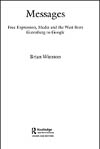
Messages: Free Expression, Media and the West from Gutenberg to Google
by Brian Winston
Free expression is in trouble.It can no longer be certain of its best protection – “the general will of the people” – as Alexander Hamilton put it over two centuries ago. Today, the public, faced with the excesses of tabloid journalism and explicitness of all kinds in other media, appears no longer to be convinced that free expression is a crucial foundation of civil society. Yet, for all its faults, free expression under the law has, as Churchill once said of democracy, to be better than any alternative system.
Messages is a search for the origins of media forms, from print and stage to photography, film and broadcasting. With a wealth of illuminating anecdotes and quotations, Brian Winston clearly and forcefully argues, in jargon-free language, that the development of mass media has been an essential engine underpinning all human rights and driving the Western concept of the individual.
The Lighting Research Center
Light and Health
The Light and Health program at the LRC bridges the gap between science and applications by striving to better understand how the visual and circadian systems work and what lighting characteristics affect them, and by developing the means of applying and measuring light that is effective to both visual and circadian systems.
Biological rhythms that repeat approximately every 24 hours are called circadian rhythms. Light is the main stimulus that helps the circadian clock, and thus circadian rhythms, keep a synchronized rhythm with the solar day. Humans need to be exposed to a sufficient amount of light of the right spectrum, for a sufficient amount of time, and at the right time, for our biological clocks to remain synchronized with the solar day. Otherwise, we may experience decrements in physiological functions, neurobehavioral performance, and sleep.
Lighting characteristics that are effective to the circadian system are different than those effective to the visual system. In order to apply light to mitigate the symptoms of Alzheimer’s disease, seasonal affective disorder (SAD), jet lag, and sleep deprivation, we need a better understanding of the quantity, spectrum, timing, duration, and distribution of light that is effective for the circadian system.
Recent research has shown that:
- Light can alleviate seasonal depression.
- Light can increase the length and quality of sleep.
- Light can consolidate sleep/activity patterns in Alzheimer’s Disease patients.
- Light can improve the performance of night-shift workers.
- Light can improve weight gain in premature infants.
- Light activation of the circadian system is affected by a newly discovered photoreceptive mechanism in the eye.
- Light regulates melatonin, which has been shown to reduce breast cancer growth.
- Light has a direct impact on cortical brain activity.

Daylighting
Daylighting reduces the need for electric lighting by introducing daylight into a building. Effective daylighting is achieved through the strategic placement of skylights and windows, as well as lighting controls that monitor available daylight and respond as needed to decrease or increase electric lighting.
Lighting Research Center researchers have identified and evaluated new, simple concepts for daylight harvesting, a way to increase energy savings by taking advantage of the natural light entering a space through windows or skylights.
“Automatic switching is a daylight harvesting method designed for rooms with copious amounts of daylight,” said Leslie. “By taking advantage of natural light and using systems that turn off light fixtures for a portion of the day, we could significantly reduce energy consumption and the growing strain on the nation’s power grid.”
Typical daylight harvesting systems include a photosensor paired with a dimming ballast to control fluorescent lighting, dimming the lights proportionally to the amount of daylight entering the work space. However, full-dimming ballasts are expensive and photosensors are usually difficult to program and install.
The LRC set out to improve upon existing daylight harvesting technology and design a system that meets all of the following goals:
- easy to install and retrofit, or incorporate into existing fixtures
- inexpensive to manufacture
- achieves high energy savings
- does not annoy occupants
- no high design or programming costs
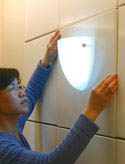
Technologies
A number of different technologies make lighting possible, including various light sources, lighting fixtures (known as luminaires), and lighting controls. Light sources include the traditional incandescent and fluorescent lamps, high-intensity-discharge lamps, and now solid-state devices that promise to change the way we light our world. Ballasts regulate the power to some of these light sources. Controlling the lighting systems are switches, dimmers, occupancy sensors, photosensors, and even automatic systems that can reduce electric load demand when needed.
The LRC tests, evaluates, and develops all types of lighting technologies in order to promote lighting that is energy efficient, reliable, and easy to use.
Scientists at the Lighting Research Center have developed a method known as “SPE” to get significantly more light from white LEDs (light-emitting diodes) without requiring more energy.
“We have developed a technology based on a new scattered photon extraction (SPE) method that will speed up the progress of solid-state lighting and help secure our nation’s energy future,” said Nadarajah Narendran, Ph.D., director of research at the LRC. “The new technology dramatically increases light output and efficacy of white LEDs, and could play a fundamental role in the evolution of white LEDs for lighting in homes and offices.”

European Futurists Conference

3rd European Futurists Conference Lucerne
19-21 November 2007, Culture and Convention Centre Lucerne
Improve your foresight approach! That is the motto of this year’s European Futurist Conference in Lucerne. The most significant independent future research conference in Europe offers more than fluffy trend prognoses. It’s the interface between science and practice. Its goal is the improvement of the future competence of decision makers in the areas of economics, society, and politics.
Agenda

| The Season Events are on Thursdays Registration: 18:30-19:00, Conference: 19:00-21:15 | ||
| November 29 18:30 – 21:15 | the future of Google and its impact on Media & Entertainment NEW LOCATION : De Industrieele Groote Club, Dam 27, Amsterdam | |
| January 31 18:30 – 21:15 | the future of Fashion Location: | |
| February 28 18:30 – 21:15 | the future of NanoEnergy Location: | |
| March 27 18:30 – 21:15 | the future of Ecological Architecture Location: | |
| April 24 18:30 – 21:15 | the future of Money Location: | |
| May 29 18:30 – 21:15 | the future of Children Location: Info.nl, Sint Antoniesbreestraat 16, 1011 HB Amsterdam [Next to Nieuwmarkt] | |
| June 26 18:30 – | Taste of Diversity – the future of INDIA Location: 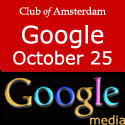 |
Club of Amsterdam Open Business Club
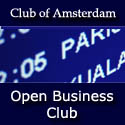 | Club of Amsterdam Open Business Club Are you interested in networking, sharing visions, ideas about your future, the future of your industry, society, discussing issues, which are relevant for yourself as well as for the ‘global’ community? The future starts now – join our online platform … |





Customer Reviews
Thanks for submitting your comment!